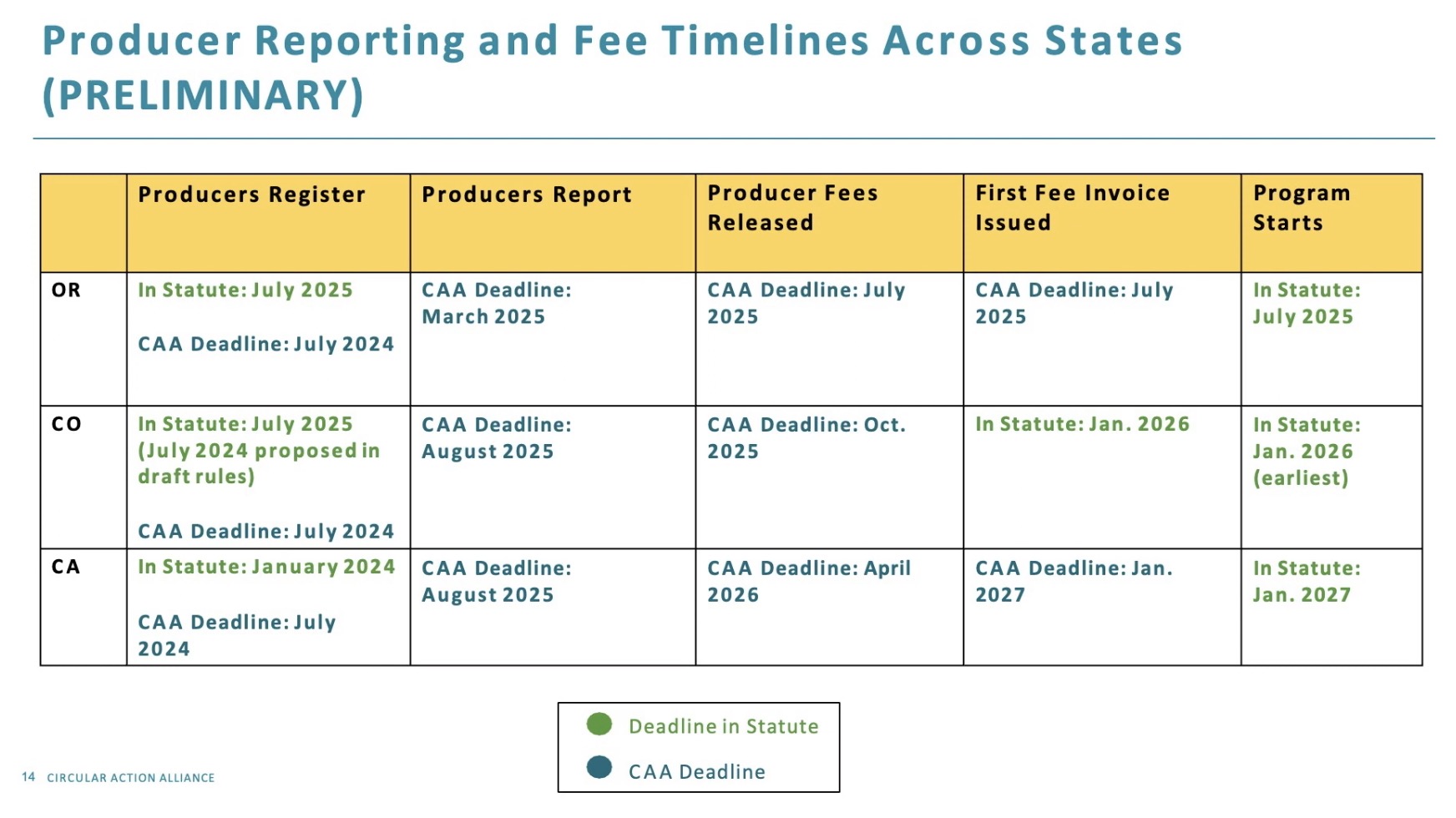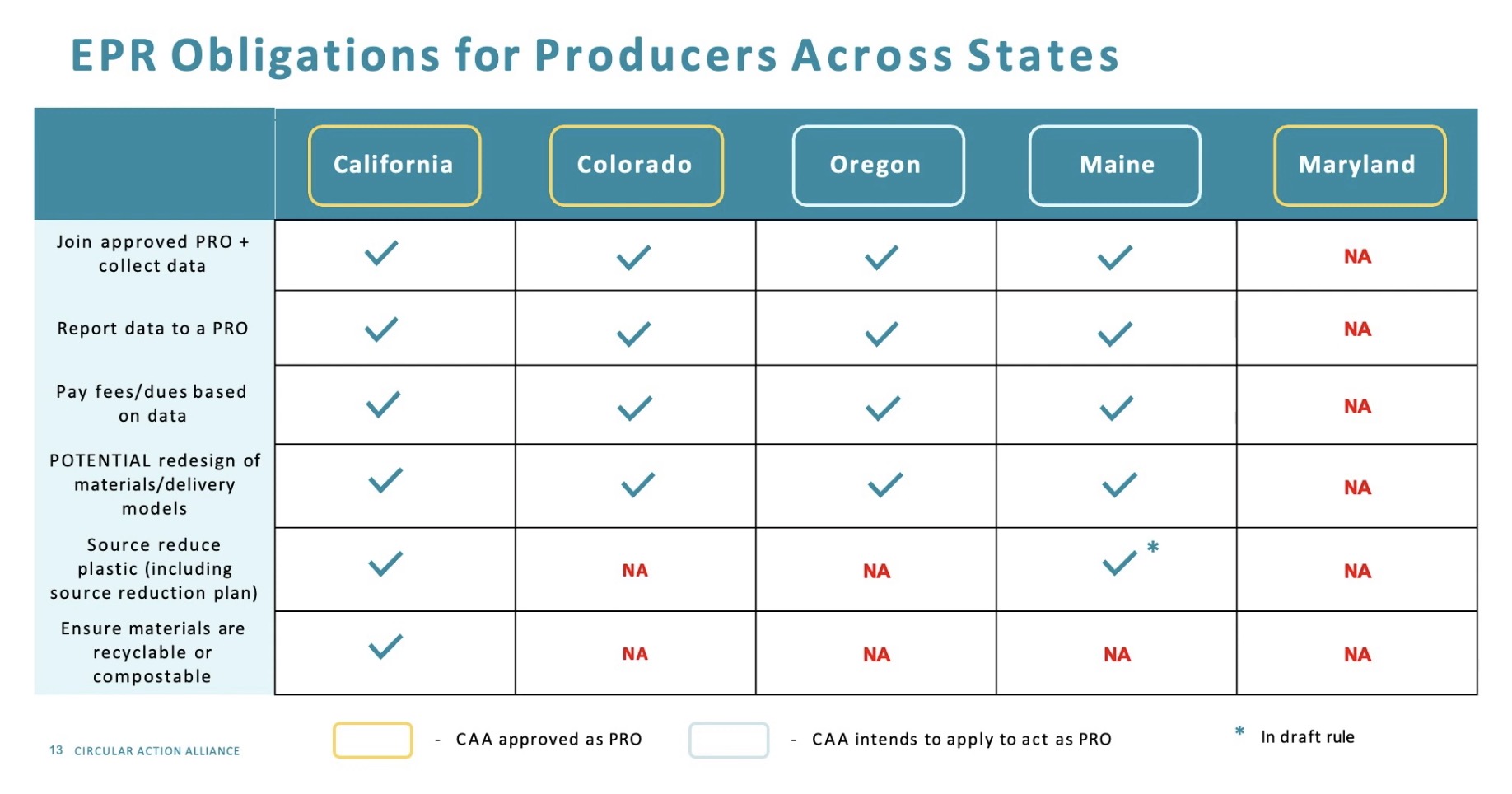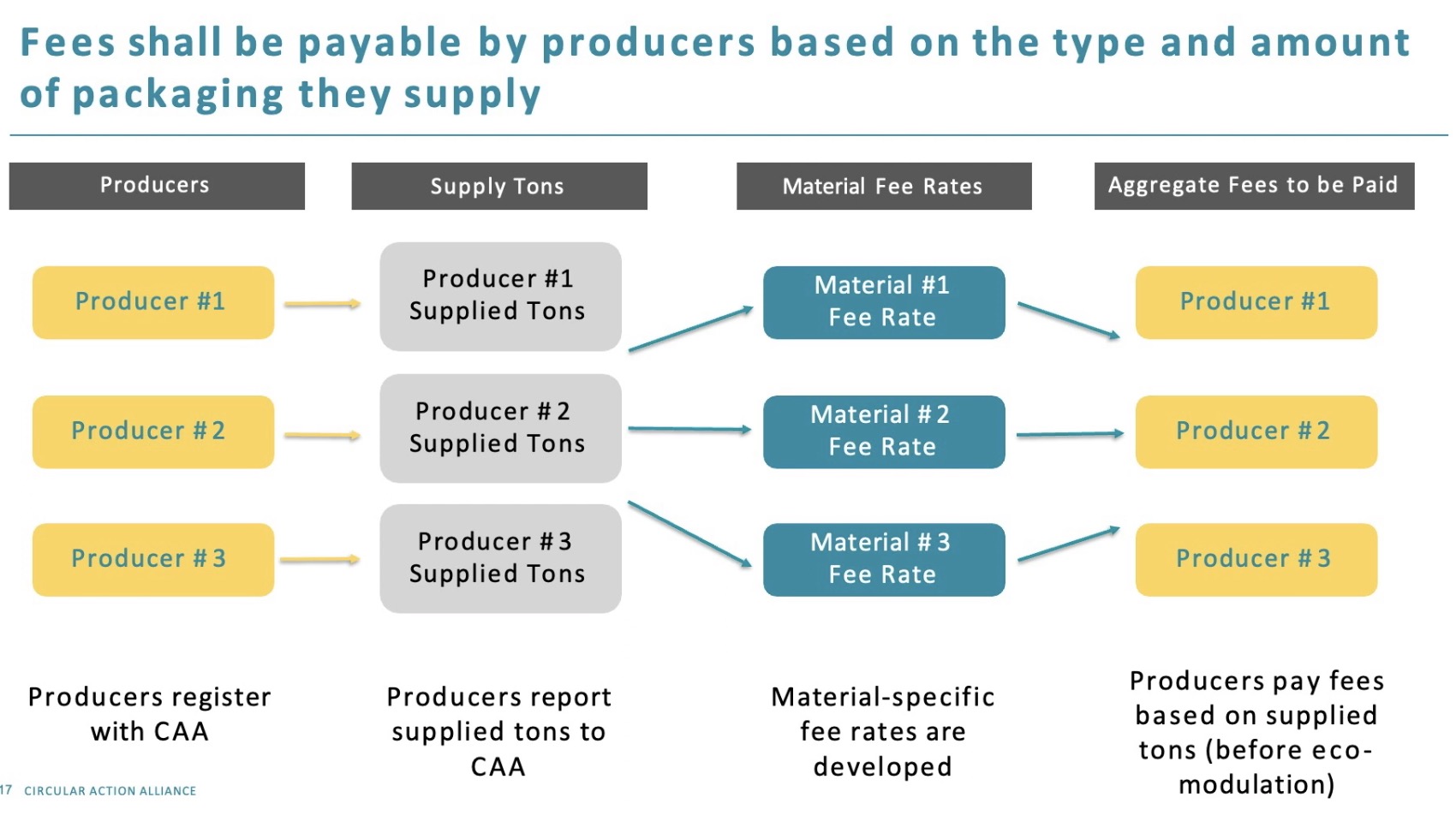On March 20, AMERIPEN presented their second webinar in a series focusing on EPR. This session discussed the role of the producer responsibility organization (PRO) and how they help streamline program reporting and fees and the types of data needed from raw material providers to waste haulers. Dan Felton, AMERIPEN’s Executive Director, thanked the sponsors, partners and supporters and introduced the single speaker for the talk, John Hite, Regulatory and Stakeholder Engagement Advisor for the Circular Action Alliance (CAA). This organization is the first U.S. non-profit PRO dedicated to implementing effective EPR laws for paper and packaging in the U.S. Founded by 20 companies from the food, beverage, consumer goods, and retail industries, it has currently been approved to be the single PRO in California, Colorado and Maryland, and the only PRO intending to submit a program plan in Oregon.
CAA’s mission is to provide producers with consistent EPR services (single point of compliance) across multiple states while developing and implementing EPR programs that meet state-specific regulatory requirements, leverage existing recycling systems and infrastructure, and advance the circularity of covered materials through collaboration with local governments, service providers, and recycling system stakeholders. It is flexible and adaptive across states while meeting unique and individual needs per state.
EPR Across the U.S
Covering EPR components of California, Oregon, Colorado, and Maine, Hite pointed out that California covers single use packaging and plastic single use in foodservice areas (residential, commercial) with funding involving the end-of-life management of covered materials, education, and investments; plus, there will be a $500M plastic pollution mitigation fund (per SB54) for 10 years (totaling $5B). In Oregon, packaging, printing, writing paper, foodservice ware (resident, some commercial) are covered. Funding comes from the processing and contamination fee paid to MRF, and direct management of certain materials through depots, education, and investments. Colorado addresses packaging, paper products, and foodservice ware (resident, some commercial). Funding comes from end of life management of covered materials, education and investments, and end market development. Finally, in Maine, packaging (resident, some commercial) is addressed with funding coming from reimbursement to municipal government for recycling and disposal of covered materials, education, and investments.
CAA was selected as the single PRO for Colorado on May 1, 2023. CAA submitted a finalized needs assessment to the Colorado Department of Public Health & Environment ahead of schedule. In California, CAA was selected as the single PRO on January 8, 2024. CAA will provide comments on CalRecycle’s draft rules during the SB 54 formal rulemaking period in 2024 and has been appointed as a non-voting member of the SB 54 Advisory Board. CAA submitted a letter of intent on September 1, 2023, to participate as a PRO in Oregon and is working on a program plan, which are required for approval. The first program plan was due March 31, 2024. Meanwhile, CAA has been engaged in Maine’s stakeholder workshops and provided comments to Maine DEP and will continue to do this throughout their formal rulemaking process. Maine will not select a PRO until 2026. In Maryland, CAA was selected to represent producer interests and serve as the single PRO on the State’s Producer Responsibility Advisory Council. It will present recommendations to the Governor and legislature for establishing and implementing an EPR program for packaging materials (i.e., MD has yet to pass a law that established an EPR program).

Hite pointed out that when it comes to CAA 2024 key deadlines and deliverables, this is important information to know in order to get through the process effectively. California has secured PRO approval and their next big steps in the process are to register producers within the organization (simple registration by July 1; participant agreements), prepare and collect producer data required for source reduction and setting, collaborate with CalRecycle on the Needs Assessment, and begin program planning. The program plan is due April 1, 2026. In Colorado, the Needs Assessment is complete, so the next steps are to Secure JBC approval of the Needs Assessment Scenario, register producers within the organization (simple registration by July 1; participant agreements), and complete program plan development. The program plan is due February 1, 2025 and will launch by January 2026. Finally, in Oregon, the complete single PRO program plan was due by April 1, 2024 with a revised plan by September 2024). Now, the next steps are to register producers within the organization (simple registration by July 1; participant agreements) and update needs assessment to support accurate budgeting and fee schedule development. Approval is anticipated by December with a program launch by July 1, 2025.
EPR Obligations for Producers Across the States
Hite shared that the process for producers across the states are to:
- Join approved PRO and collect data
- Report data to PRO
- Pay fees/dues based on data
- Potential redesign of materials/delivery models
- Source reduce plastic (including source reduction plan)
- Ensure materials are recyclable or compostable

There is one unique requirement in California and Maine. Maine has built a source reduction target into their draft rules for promulgation, while California has built a target in their requirements for SB 54. By 2032 100% must be compostable (strict requirement). The Truth in Labeling law was signed just before SB 343 with incentives through eco-modulated fee structure.
Oregon has most near-term deadlines of July 2024 with reporting in March 2025. They are working with producers to make sure they are ready. Producer fees will be released in July 2025, with the first fee invoice issued in July 2025. Considering these tight deadlines, Hite encouraged attendees to join a working group and become a member of an organization to help producers understand some of these components and requirements. In Colorado, they will be in statute by July 2025 (July 2024 proposed in draft rules), the producer report CAA deadline is August 2025, producer fees are released in October 2025, and the first fee invoice issued will be January 2026 (in statute)
Producer Services and Reporting
CAA is developing guidance materials to provide reporting instructions to producers. However, they are stil waiting for additional details to come out of the states to develop it. Once Covered Material Category (CMC) lists are finalized (expected Q2 2024), CAA will be able to provide detailed guidance materials to producers. *CMC lists are developed by CalRecycle for California and the final list will be available July 1, 2024. Until the finalized, lists come out, it will be tough for CAA to tell PRO how to report data. **Oregon is making a recommendation about categories, that list was submitted as part of CAA’s program plan on April 1, 2024. The organization’s IT team will soon start the initial development of the producer reporting portal. Once finalized, the CMCs will be added as reporting categories in the portal. CAA is projecting that the producer reporting portal will be ready to receive producers’ data in Q1 2025
So, how are producer fees determined? Hite explained they almost always vary by covered material or packaging type. The variation reflects the differences between each material in terms of (but not limited to) its quantities, cost to recycle, and recycling performance. Once the total system costs for the jurisdictions are known, the PRO will allocate these costs to producers based on the amount and type of packaging they supply. This is often referred to as fee-setting. Fees will be payable by producers based on the type and amount of packaging they supply. To fairly set fees for producers, PROs require guiding principles including clarity, harmonization across states, fee-setting methodology and approach, significant data, and modeling. This all ensures that each producer pays its fair share of fees.

Recyclability determinations across states can impact whether a producer’s material will be accepted in recycling programs or not, and if so, how it will be collected. Determination processes differ across states and reflect current recycling system capacity. Recyclability determinations are made on a subset of materials included in the scope of the state’s program. Covered material categories categorize all materials in the scope of a state’s program—only a subset of CMCs will be determined to be recyclable.
California – Source Reduction Next Steps
Hite highlighted two California Needs Assessment studies. Study #1 focused on CalRecycle working with a third-party contractor to establish the 2023 baseline and Study #3 that said CalRecycle will evaluate actions and investments needed to meet source reduction requirements, including reuse and refill (Assess design changes are needed to achieve source reduction requirements.) Now, the next steps for the CAA include educating producers on source reduction requirements, drafting and consulting on an enforceable source reduction agreement with producers, and building the reporting infrastructure to receive producer data on light-weighting, elimination, reuse, refill, and recycled content. Proposed Rule: The baseline will be updated with 2023 supply data provided by producers in the annual reports for 2027.
Preparation and Engagement
Hite emphasized that there is active rulemaking processes underway in California, Oregon, and Maine with the potential to clarify producer definitions and requirements. With regards to data preparation, consider staffing needs and reporting systems and capabilities (i.e., who is reporting within your company). He pointed out that there are service providers in the market who can give support in following CAA guidance. The first proposed producer data reporting deadline is March 2025 (Oregon); CAA anticipates releasing a detailed data collection and reporting guidebook in 2024. He encouraged attendees to begin reviewing California’s current 98 CMC categories and, most importantly, to register with the CAA and join the Producer Working Group in order to receive updates on upcoming requirements, and CAA’s activities across states and guidance to support compliance. CAA’s producer registration deadline is July 1, 2024. Early producer registration will help reduce non-compliant obligated producers in the system as well as provide CAA with more precise producer data to inform accurate and fair fee schedules. Registration consists of filling out CAA’s registration form. To ease producer compliance, CAA is working to register all producers in Colorado, California, and Oregon by July 1, 2024.
Finally, he said to stay engaged. CAA has a producer resources center, including a producer resources page with FAQs, Producer Working Group information and other updates, and a monthly newsletter with all the latest updates for each state.
AMERIPEN’s upcoming webinar, “Services to Help Collect and Report Data and Manage Fees”, will take place on April 17 at 1pm. The third in the EPR webinar series, this session will give information on what different services are available to help streamline data collection, reporting, and how you can leverage it for additional insights.
For more information, visit https://www.ameripen.org/epr-webinar-series-2024/.
